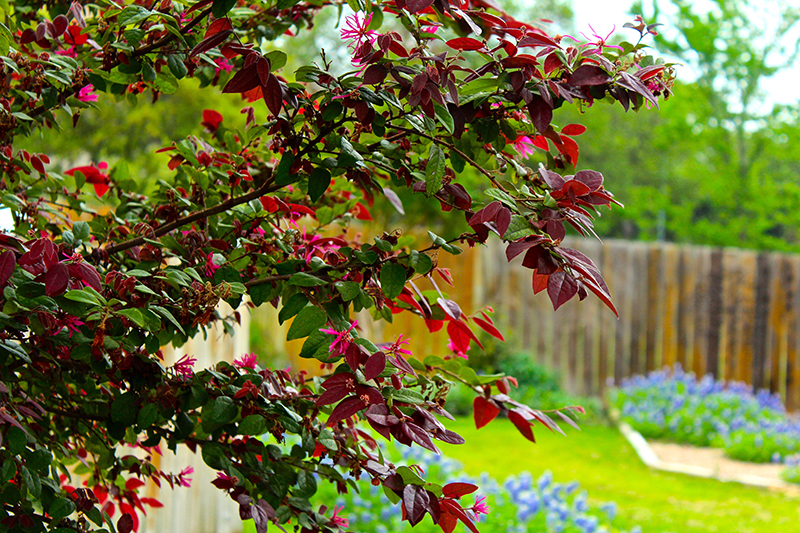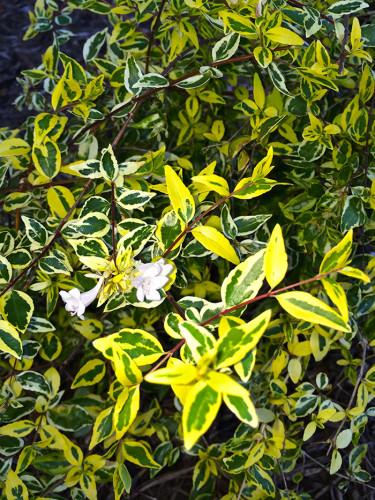
Most gardeners find themselves captivated by beautiful blooms. Nurseries put those showstoppers front and center, designed to lure in homeowners looking for the brightest, longest-lasting blooms for their landscapes. But venture further back and you’ll find the backbones of the garden – evergreen shrubs. These are the tried and true performers in the garden, season after season, year after year.
Called foundation plants, shrubs are often planted against a house to hide its foundation. They originally hid basements or open crawl spaces under homes. But they also provide a structural design foundation for layering with the other plants in the landscape.
When well placed, shrubs can soften the structure of the house and provide a transition to the surrounding landscape. A carefully crafted blend of evergreen shrubs, flowering perennials and colorful annuals makes a great formula for a beautiful garden bed. Regardless of your personal garden style, this combination provides cohesion in the landscape, allowing each unique set of plants to aid the transition of colorful interest in the garden throughout the season.
In spring, bulbs and tender annuals provide fresh bursts of color against the backdrop of established evergreen shrubs. In summer, hard-working perennials come into their own, blooming for the long haul and providing a contrast to the reliable shrubs. And in winter, when perennials are sleeping for the season, it’s the foundation shrubs that look beautiful and colorful against grey skies.
While many shrubs do bloom, they’re most often appreciated for their beautiful foliage contribution to the garden. With careful selection and design, foliage-only plants can be used to create a neutral and serene landscape, to be appreciated more for their nuances than the bright pops of color in a vivid perennial bed.
Plants, li ke people, develop issues as they age. Many shrubs tend to get leggy, with little or no foliage on the lower branches – caused, among other things, by poor pruning or a lack of sunlight from above. Overgrown shrubs are a common problem faced by homeowners. Homebuilders often plant large, fast-growing shrubs in very small spaces along walkways and under windows. When the plants outgrow the space in a few short years, these colossal shrubs can obscure the beauty of the house, leaving homeowners to fight their way into their own house with a machete. Sometimes it’s just time to put them out of their misery.
ke people, develop issues as they age. Many shrubs tend to get leggy, with little or no foliage on the lower branches – caused, among other things, by poor pruning or a lack of sunlight from above. Overgrown shrubs are a common problem faced by homeowners. Homebuilders often plant large, fast-growing shrubs in very small spaces along walkways and under windows. When the plants outgrow the space in a few short years, these colossal shrubs can obscure the beauty of the house, leaving homeowners to fight their way into their own house with a machete. Sometimes it’s just time to put them out of their misery.
Having seen too many instances of this, I’m always on the lookout for smaller varieties of my favorite shrubs. This ensures that the mature size of the plant is the proper size for the space, and saves homeowners from having to constantly prune a plant that’s just growing the way it’s supposed to grow. Certainly, gardening is work and requires care and pruning, but planting a 6-foot wide shrub in a 2-foot-wide bed just isn’t going to work.
Evergreen shrubs for Central Texas Gardens
There are many hardy shrubs that grow well in Central Texas. Here are a few of my favorite small to medium-sized shrubs.
Evergreen shrubs aren’t always green. One of my favorites is the Loropetalum family of shrubs which range in color from an olive green to burgundy and even deep purple leaves. It’s also known commonly as Chinese fringe flower and comes in a wide variety of sizes from 2-4 feet tall and wide to as much as 6-10 feet tall and wide. There are many different color options from which to choose. The color of the leaves on some varieties can also vary depending on the light and soil conditions where they are planted. The shrub’s beautiful wispy, fringe-like pink blooms appear at various times throughout the year. I have several varieties, the small, ground cover-like ‘Purple Pixie,’ and a medium-sized variety, ‘Daruma.’ I also have a larger, mystery variety, which I have pruned up as a small tree. I’ve found them to be fairly drought tolerant once established and pest and disease free.
There are several variegated varieties of abelia that are my go-to shrubs. ‘Kaleidoscope,’ ‘Twist of Lime,’ and ‘Hinkley’s’ abelias are great for adding contrast and light into a bed. With varying degrees of lime and cream in the leaves, and some with rust-tinged edges in the fall, these three varieties are small- to medium-sized shrubs that grow about 4-5 feet tall and wide. They have white blooms several times through the year. There are many other abelias – with glossy, dark green leaves, with pink blooms, and much larger varieties of plants as well.
And no list of evergreen shrubs in Central Texas would be complete without Dwarf Yaupon Holly. This tough-as-nail plant doesn’t even miss a beat in our hot, dry summers. Compact and a nice medium size of 2-4 feet tall and wide, dwarf yaupon holly rarely needs pruning as it grows naturally into a very orderly-shaped orb.
Dwarf ‘Cream De Mint’ Pittosporum adds another interesting element to the landscape – a different form than many other common shrubs. This pale green and cream leaf is larger and somewhat rounded. Its growth habit is dense and compact and requires little upkeep. This can also be pruned into an interesting understory plant.
I’ve been growing the Leatherleaf Mahonia in my garden for quite some time now. It’s a spiky, upright shrub that’s right at home among cacti and agaves and yuccas and produces cool yellow bloom spikes in winter, followed by tiny, bluish black berries. Several years ago I had an opportunity to trial a different variety, the ‘Soft Caress’ Mahonia. They couldn’t be more different. The “Soft Caress’ looks like its name. Fine leaves drape delicately from this small shrub, providing a soft look in a shady garden. While it produces similar blooms and berries, it’s welcome and inviting, offering a beautiful contrast to woodier shrubs with waxy or stiff leaves.
I often mix in shrubs with variegated leaves, interesting forms, or colors other than green, to provide contrast in the garden. When landscape beds contain several layers of shrubs, all with medium-sized, glossy green leaves, none of the plants can stand out and shine it’s just a wall of green. When the combination contains one such shrub, but the other shrubs or plants are variegated or have dramatically different leaves, colors, leaf finish, forms or textures, it adds depth to the entire bed, enabling you to distinguish each unique plant from the others.
Once established, most of these shrubs are average to low water users. That means they will need a little more watering in the beginning to get them going, depending on the time of year in which you plant.
So, if you’re thinking of refreshing your landscape this spring, start with some unique foundation shrubs as the building blocks to enhancing your curb appeal.
Local Landscape Designer and Garden Coach, Diana Kirby, provides landscaping tips on Facebook at Diana’s Designs, at www.dianasdesignsaustin.com and writes a garden blog at www.dianasdesignsaustin.com.


Leave A Comment